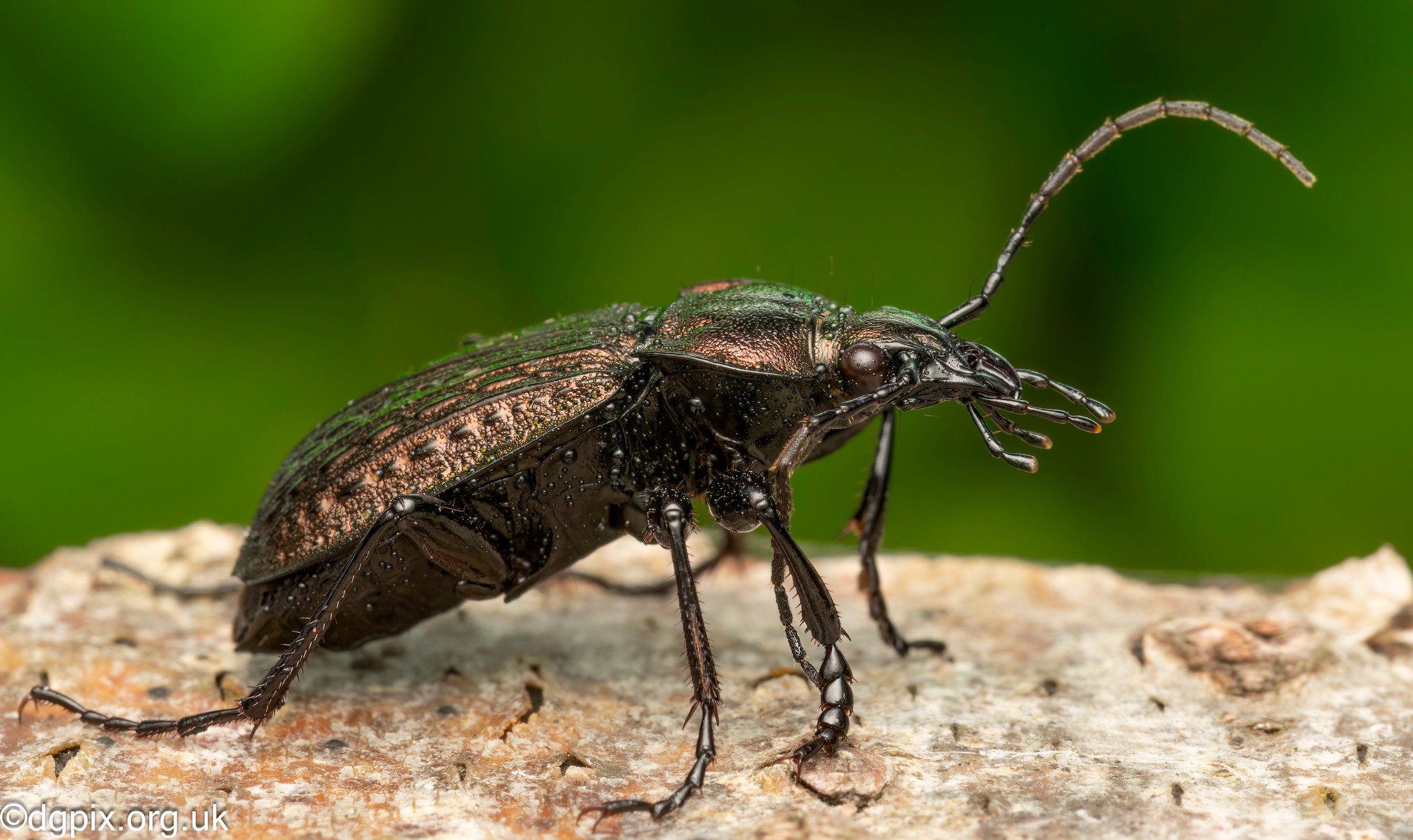
Photographing Carabus granulatus: A Conservation Perspective
Peat bogs, with their rich biodiversity, provide a perfect setting for photographers and naturalists alike. Among their insect fauna is the ground beetle Carabus granulatus, a fascinating subject for closeup and macro photography. Known for its metallic sheen and textured elytra, this beetle epitomises nature's artistry, making it an irresistible target for those with a camera in hand.
Finding Carabus granulatus
Photographing Carabus granulatus begins with locating its preferred habitats. This beetle thrives in wetland areas, including riverbanks, bogs, and damp grasslands. Northern Ireland's freshwater ecosystems, such as those along the River Lagan, Bann or the wooded shores of Lough Neagh, offer ideal conditions for encountering these elusive insects. While their nocturnal behaviour might make them challenging to spot, patience and a keen eye can reveal their presence.
In springtime look under logs and large stones, where ground beetles often shelter.
The beetles are particularly active during warm, humid nights, so planning your photography expeditions during such conditions can increase your chances of success. Turn over logs or stones and examine damp soil; just be sure to handle the habitat with care to minimise disturbance.
Beetle Photography
The beauty of Carabus granulatus lies in its intricate patterns and metallic colours, which require macro techniques to capture effectively. Here are some tips for getting the best results:
- Lighting: Natural light often works - but for the best showcasing of the beetle's iridescent body use some heavily diffused flash. Early morning or late afternoon light casts softer shadows and enhances its natural colours. For night time sessions, bring a diffuser to avoid harsh reflections from artificial light sources. I use the Popeshield Diffuser system, and it's a great bit of kit for this work.
- Macro Lens: Carabus granulatus is small, so using a macro lens is essential for close-up shots. Experiment with angles to highlight the granulated texture on the beetle's elytra, or try a head on face shot to capture the large mandibles.
- Background: A clean, unobtrusive background ensures the beetle remains the focal point. You can use foliage or moss to create a naturalistic setting that complements its habitat.
- Patience: Wildlife photography requires patience, especially when dealing with unpredictable insects. Observe their behaviour, and wait for moments when they pause or interact with their surroundings. Look under logs and stones and don't chase beetles, let them stop in their travels and time your shots.
- Knowledge: Knowing your subject and it's behaviours is key to any nature photography session, so learn about ground beetles and their natural history.
For these shots I used:
- Canon R7
- Sigma 105mm macro lens
- Godox V1 Speedlight
- Popeshield diffuser system
-Edit-Edit.jpg?width=2797&height=3000&name=2025-04-20%2014-20-42%20(B%2cR34%2cS7)-Edit-Edit.jpg)


Conservation Perspective
Carabus granulatus, like many ground beetles, plays a crucial ecological role as both a predator and an integral part of nutrient cycling. Here are some key contributions:
- Predation: This beetle is a voracious hunter, feeding on a wide variety of invertebrates, including slugs, snails, and other insects. By controlling populations of these species, Carabus granulatus helps maintain a balance in ecosystems, preventing any one group from overpopulating and causing harm to vegetation.
- Decomposition Assistance: While primarily a predator, it also consumes decaying organic matter. This activity aids in the breakdown of organic materials, promoting nutrient recycling in the soil and fostering healthier ecosystems.
- Indicator Species: Due to its sensitivity to environmental changes, Carabus granulatus serves as an indicator species. Its presence (or absence) can offer valuable insights into the health of an ecosystem, particularly in wetland and freshwater habitats.
By fulfilling these roles, Carabus granulatus contributes to the overall stability and biodiversity of the ecosystems it inhabits. Its activities highlight the interconnectedness of species and the importance of conserving habitats where such beetles thrive. Have you observed Carabus granulatus in the wild during your conservation work? I bet it makes for a fascinating study under the lens with your own style of photography!

